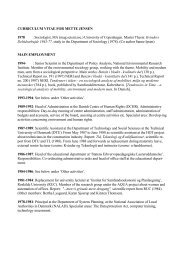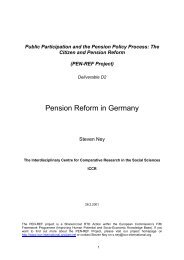The Housing Dimension of Welfare Reform - the ICCR
The Housing Dimension of Welfare Reform - the ICCR
The Housing Dimension of Welfare Reform - the ICCR
You also want an ePaper? Increase the reach of your titles
YUMPU automatically turns print PDFs into web optimized ePapers that Google loves.
oadly and attention must thus be focused on housing policies and <strong>the</strong>ir<br />
effects on <strong>the</strong> population more generally and not only on specific risk<br />
groups. In <strong>the</strong> latter case, one is more interested in exploring how to<br />
avoid homelessness or support <strong>the</strong> re-housing <strong>of</strong> homeless persons.<br />
However, even if <strong>the</strong> focus <strong>of</strong> <strong>the</strong> analysis will thus vary, a<br />
comprehensive analysis <strong>of</strong> ei<strong>the</strong>r <strong>the</strong> policy level or <strong>the</strong> programme level<br />
cannot ignore <strong>the</strong> specific or <strong>the</strong> global context respectively. <strong>The</strong><br />
comparative assessment <strong>of</strong> policies must consider how <strong>the</strong>se operate at<br />
<strong>the</strong> local level <strong>of</strong> programme or project implementation through services,<br />
while an evaluation <strong>of</strong> a specific programme or service must take into<br />
account <strong>the</strong> generic policy context and how this facilitates or constraints<br />
<strong>the</strong> implementation <strong>of</strong> specific programmes.<br />
Historical and prospective institutional analysis<br />
Each policy or programme has its history, which influences <strong>the</strong> norms<br />
and values <strong>of</strong> <strong>the</strong> institutional actors in charge <strong>of</strong> its operation and thus –<br />
directly or indirectly – its modus operandi. This is particularly true <strong>of</strong><br />
social policies or programmes which are embedded in <strong>the</strong> long tradition<br />
<strong>of</strong> <strong>the</strong> welfare state(s).<br />
Important for any policy or programme evaluation is to understand how<br />
<strong>the</strong> latter have developed in time – in terms <strong>of</strong> ideas, interests and main<br />
actors. This is especially important when studying a specific policy or<br />
programme with a view <strong>of</strong> determining scenarios for <strong>the</strong> future or <strong>the</strong><br />
possible institutional impacts <strong>of</strong> specific reform plans.<br />
Charting aggregate outcomes with <strong>the</strong> help <strong>of</strong> indicators<br />
Institutional analysis is a standard task for political science specialising<br />
on (public) policy analysis. <strong>The</strong> use <strong>of</strong> indicators for studying <strong>the</strong><br />
outcomes <strong>of</strong> policies falls instead under <strong>the</strong> realm <strong>of</strong> quantitative<br />
sociological or economic analysis. It is equally important for policy<br />
evaluation.<br />
Large comparative surveys provide <strong>the</strong> best source for <strong>the</strong> construction <strong>of</strong><br />
aggregate indicators. In <strong>the</strong> field <strong>of</strong> social policy relevant datasets are <strong>the</strong><br />
European Community Household Panel Survey (ECHP) (used in <strong>the</strong><br />
EUROHOME-IMPACT project) as well as its follower <strong>the</strong> Survey on<br />
Income and Living Conditions in Europe (SILC); <strong>the</strong> Household<br />
Expenditure Survey; <strong>the</strong> Labour Force Survey; as well as national<br />
censuses or micro-census programmes.<br />
<strong>The</strong>re are different indicators that are <strong>of</strong> relevance for benchmarking<br />
exercises and <strong>the</strong>se can be classified into different categories according<br />
to <strong>the</strong>ir degree <strong>of</strong> relevance for <strong>the</strong> analysis. Clearly some indicators –<br />
EUROHOME-IMPACT FINAL REPORT 64









